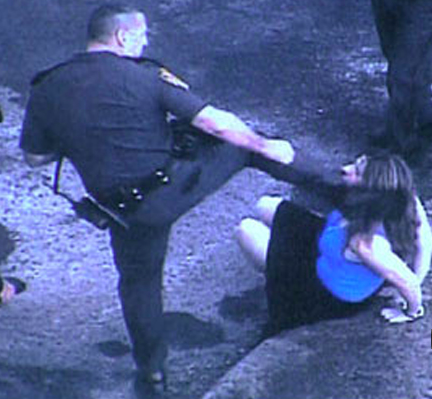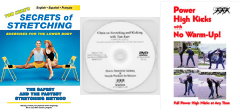by Thomas Kurz
In this third article on common errors in basic kicks, you will learn how to recognize and fix errors in the roundhouse kick.
The purpose of the roundhouse kick is to strike a target from the side. So, either the neck or the temple, floating ribs, sides of the thighs, or sides of the knees of an opponent are struck when the opponent is facing you; or the stomach, face, back of the head, kidneys, or back of the thigh is struck when the opponent is standing sideways to you.
Roundhouse Kick—Correct Form
Correct form of the roundhouse kick (karate’s mawashi geri and taekwondo’s dollyo chagi)
— Stand in a front stance. While planting the supporting foot, move your whole body forward.
— When you start the pivot on your supporting foot, throw your flexed leg and its hip at the target—straight at the target, not to the side. Toes of your supporting foot point away from your target—they are at about 135° or more from the line formed by your kicking leg.
— Chamber as if aiming higher than you need to for a given target. Either an insufficiently high chamber or lowering the knee while the lower leg is thrown at the target can cause pain at the side of the knee. The higher you kick, the higher you should chamber your kicking leg (in other words, raise your flexed leg so its knee points at or above your target).
Note: In low roundhouse kicks, to thighs or to knees, used in a very close distance, chamber by lifting the thigh to the side to compensate for the impossibility of throwing the whole body forward—there is not enough room to generate momentum by moving forward, so instead a rotation in place is used—a weaker alternative, but it may suffice in the circumstances.
— Rotate the thigh and unfold the lower leg from the chamber to strike your target with your shin, your instep, or the ball of your foot. (Kicking with the ball of the foot should be done only after learning to kick with the instep—I explain why on the DVD Clinic on Stretching and Kicking.) The arm on the same side as the kicking leg drops behind your back. The arm on the side of the supporting leg protects your face. Simultaneously drop your trunk. When beginning to learn the high roundhouse kick, you may need to lean your trunk so low that your head is below your hips. With practice you will reduce the amount of this lean. See your target over your shoulder (over the right shoulder for the right kick, over the left shoulder for the left kick).
— Return to the chamber (without lowering the knee), and after the return, lower the leg.
Roundhouse Kick Errors
1. Side chamber—slows down and weakens the kick. Puts unneeded stress on the lower back and on the hip joints. It also makes it difficult to throw this kick cold. Chambering by lifting the thigh to the side causes hip pain and possible inflammation. The reasons are explained in my article on the side kick. Further, a side chamber makes your roundhouse kick vulnerable to ashi dome (leg greeting—a foot block). On the DVD Clinic on Stretching and Kicking, I show how ashi dome stops typical martial artists’ roundhouse kicks and how a correct chamber takes away effectiveness of this block.
Cause: Confusion (i.e., wanting to apply the form of movement designed for low-level roundhouse kicks—usually to the knees and thighs and at most to the stomach—to high roundhouse kicks).
Remedy: Study actual fight footage of knockouts and knockdowns with high roundhouse kicks.
2. Low chamber—limits power and height at which you can kick—just as in the case of the side kick. It also is a sign of poor conditioning, weak hip flexors, and a weak lower back.
Causes: It is most often caused by teaching roundhouse kicks to people who are not proficient with high knee kicks and who do not have sufficient conditioning—the fault of an instructor. Another cause is the attempt to stay upright (i.e., not leaning or dropping the trunk down when chambering the leg). The kicking leg and the trunk are the two pans of a scale, balancing on the supporting leg. The lower you lean your trunk, the higher you can raise your chambered kicking leg.
Remedy: Core strengthening until one is able to comfortably stand on one leg, chamber high, and slowly rotate the thigh and unfold the lower leg from the chamber and return to the chamber. Learn to drop the trunk as the leg is chambered.
3. The knee of the kicking leg drops below the kicking foot, even as that foot travels toward the target. Also a sign of poor conditioning and poor strength of hip abductors, hip flexors, and lower back muscles—all the muscles that keep both the kicking thigh and the trunk up.
Causes: The same as for the low chamber.
Remedy: Same as for the low chamber plus kicking a heavy bag (doesn’t have to be hard) with the instep and the lower part of the shin, starting low and gradually raising the height of the roundhouse kicks. With every kick, from the lowest, pay attention to the shin being in one line with the thigh at the impact, and then return to chamber before lowering the thigh.
4. Nonpenetrating kick—a roundhouse kick that is powerlessly raised to a target and then quickly snapped back. This is typical for students who were taught poorly—were not shown the correct form often enough and were not corrected early on—as well as those who fake whatever they do.
Causes: Not mastering the lead-up skills—the straight punch, the front knee kick, the groin kick, the front thrust kick, the side thrust kick—the purpose of each I explain in my article “High Kicks with No Warm-Up: The Right Body Alignment for Great Height and Power in the Roundhouse Kicks.” Not taking the training seriously by a student or poor instruction. Enrolling students who do not belong in martial arts, and perhaps a fake instructor who admits such to a class and then does not bother (or know how) to teach correctly. Willing but naive students, those who can’t find a real instructor, may display this error if required to kick high before sufficiently learning all lead-up skills.
Remedy: Learn well the lead-up skills. Practice those skills until each is mastered. If needed, find an instructor who teaches the lead-ups skill well. Also, begin with the easiest form of the kick, at low target like shown in a photo below:
Police officer practicing a roundhouse kick on a seated handcuffed woman.
In the next article you will learn how to fix errors in the hook kick.
If you have any questions on training you can post them at Stadion’s Sports and Martial Arts Training Discussion Forum.
Get the most to-the-point info on the fastest method of achieving high kicks and splits with no warm-up!
On these three DVDs you will find the best instruction on flexibility and stretching for martial arts, such as karate, kickboxing, kung-fu, taekwondo—any arts that employ high kicks.
Click here to save 25% off the regular price of $129.85! Buy these three DVDs in our Kicker’s Bundle for $97.39 and save $32.46!



Great video. Thanks for sharing this information and insights too.